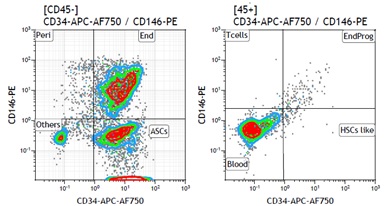Ex vivo Expansion of Human Adipose Stromal Cells

ASCs are anchorage-dependent cells and have been routinely cultivated as monolayers adherent to tissue culture polystyrene substrate. This technique has been proven to be inadequate for large scale manufacturing of stem cells since a loss in the capability of self-renewing, colony forming and differentiating potential is observed long before a sufficient number of cells for transplantation is obtained. Moreover, this system configuration lacks control of important cell culture parameters like pH and pO2, requires intensive manipulation by human operators and has poor scalability. Alternatively, ASCs can be grown in a 3D configuration as multicellular aggregates (or spheroids). This 3D configuration preserves the native phenotype and biological properties of the cell and allows anchorage-dependent cells to grow in suspension bioreactors.
In terms of therapeutic efficacy, ASCs spheroids have been directly administrated to the site of injury of mice for the treatment of diabetic wounds (Amos et al., 2010), or skin wounds (Hsu & Hsieh 2014), showing increased wound repair and angiogenesis compared to mice treated with ASCs derived from monolayer cultivation. Improved therapeutic efficacy was also reported for the treatment of ischemia in mouse with ASCs grafted as spheroids (Bhang et al., 2011). Despite the regeneration potential, the amount of stem cells obtained from liposuctions and other surgeries is limited, and an efficient expansion process prior to the clinical application is required. For this step, closed sterile systems like bioreactors are required. The use of this type of devices has the aim to facilitate mass transport while allowing monitoring, feedback control of the culture environment and automation of the feeding strategy. This project aims to develop a large scale manufacturing method for the production of ASCs in compliance with the strict European regulation concerning “Advanced Therapy Medicinal Products” (ATMP). This step will consist first in the transfer from static to suspension cell culture, with the evaluation of different operation modes (fed-batch, perfusion), operating setups and process conditions (medium components, T, pH, DO, pCO2, perfusion rate). Of particular interest is the use of serum-free and xeno-free formulation for the culture media.